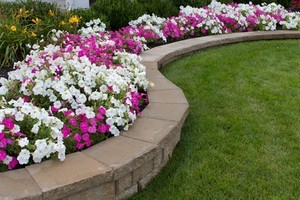Types Of Retaining Walls & What They’re Most Useful For
 Retaining walls have a number of uses and many practical advantages to the homeowner. Generally, the main purpose is to prevent the erosion of sloped earth that may threaten to shift and slide. This erosion is potentially damaging to your home or property.
Retaining walls have a number of uses and many practical advantages to the homeowner. Generally, the main purpose is to prevent the erosion of sloped earth that may threaten to shift and slide. This erosion is potentially damaging to your home or property.
Retaining walls are also a particularly effective tool in climates with heavy precipitation due to rainwater runoff. Not only will a retaining wall properly support sloping earth, but it will also act as an effective means of draining water runoff and of reducing hydrostatic pressure.
Furthermore, they provide a number of agricultural benefits. For warmer, dryer climates, a wall can delay seepage of water from land, and for wetter climates, properly drained walls can divert water from areas prone to flooding.
In addition to practical purposes, these structures maintain a certain aesthetic value as well and sometimes they are built as an entrance to an estate or for just sectioning off certain areas of a property. As such, adding one may increase the resale value of your home, while also enhancing the own enjoyment of your outdoor areas.
For example, a wall can be constructed in a series of steps or levels, granting you unrestricted creativity to include all kinds of plantings, flowers, or other elements that will add texture, color, and new life to each successive level. Not to mention, stepped retaining walls have proven to be a more effective form of erosion control.
Retaining Wall Options in Springfield
Since these structures provide support for vertical grade changes, an effective one must be constructed in such a way as to accommodate and redistribute the lateral pressure caused by sloping. As a result, they vary in size and type, and often include materials like stone, brick, concrete, vinyl, steel, and pressure treated timber.
If you’re brainstorming ideas for a retaining wall, the following are common retaining wall types.
- – Gravity retaining walls rely on their mass to hold back pressure. Often these walls are constructed from large pieces of stone, concrete, or other heavy materials that are often a composite of elements including steel, rock, timber, soil, and concrete.
- – Sheet pile retaining walls are utilized for soft earth and limited space. These walls are typically constructed from thin sheets of steel, vinyl, or wood which are driven into the ground.
- – Cantilevered retaining walls were more popular before the introduction of gravity walls. These walls are typically taller and fashioned from thin stems of steel-reinforced concrete in Boston often cast in the shape of inverted T. In effect, they will “cantilever” loads, diverting pressure downward toward the strong base instead of forward. The advantage to this particular type of wall is that it uses less material than most others.
- – Anchored retaining walls employ the use of anchors placed behind the wall (into the earth) for support. The size and shape of anchors vary, and a number of different methods are used to place them. They are typically used when either high loads are expected or the wall itself is required to be thin, rendering it too weak to stand alone.




